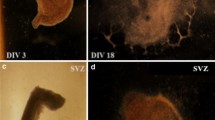Summary.
Perinatal hypoxia is known as a high risk factor for the development of long-lasting abnormalities in dopaminergic system. The early developmental alterations of dopamine (DA) metabolism induced by hypoxia could contribute to these abnormalities. To understand the hypoxia-induced changes of intra- and extracellular dopamine levels and its main metabolites, 3,4-dihydroxyphenylacetic acid (DOPAC) and homovanillic acid (HVA), in immature dopaminergic neurons, we compared these changes in rat mesencephalic and diencephalic cell cultures on day in vitro (DIV) 2 (immature cells), DIV 8 and DIV 13 (mature cells). Cell cultures were exposed to an oxygen-free gas mixture in a Billups chamber for 2–4 hours. Mature cell cultures responded to hypoxia with an increase of DA levels in the cells and in the medium during the first 45 min (by an average of 57 and 114% respectively). Thereafter, DA levels decreased, and returned to the baseline within the next 30 min. The cellular DA levels continued to decrease up to 15% of the baseline during 255 min hypoxia whereas the extracellular DA content stabilized at the prehypoxic levels. Immature cell cultures (DIV 2) in contrast to mature ones, were unable to maintain normal extracellular DA levels during hypoxia and showed a decrease of the cellular and extracellular levels to 50% of the prehypoxic levels. DOPAC and HVA changes mimick, however, at a lower level, the pattern of DA changes during the exposure to hypoxia. In principle, in the diencephalic cell culture similar effects of hypoxia exposure on the investigated parameters were found (studied during 0–120 min).
The present study demonstrates that mature and immature dopaminergic cells differ in the regulation of the extra- and intracellular DA levels during hypoxia. In immature cells the low synthetic capacity of tyrosine hydroxylase and the deficient capacities of the transport and storage processes result in decreased extracellular DA levels. This could be an important factor for the long-term modulation of the expression of tyrosine hydroxylase and subsequent long-term behavioral and/or neurological abnormalities induced by perinatal hypoxia.
Similar content being viewed by others
Author information
Authors and Affiliations
Additional information
Received June 8, 1998; accepted July 21, 1998
Rights and permissions
About this article
Cite this article
Gao, J., Gross, J., Andreeva, N. et al. Hypoxia induces differential changes of dopamine metabolism in mature and immature mesencephalic and diencephalic cell cultures. J Neural Transm 106, 111–122 (1999). https://doi.org/10.1007/s007020050143
Issue Date:
DOI: https://doi.org/10.1007/s007020050143




